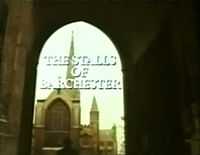The Stalls of Barchester
| "The Stalls of Barchester" | |
|---|---|
| A Ghost Story for Christmas episode | |
|
Title screen, showing Barchester Cathedral (Norwich Cathedral). Doctor Black is seen passing through the arch. | |
| Episode no. |
Season 1 Episode 1 |
| Directed by | Lawrence Gordon Clark |
| Written by |
M. R. James (story) Lawrence Gordon Clark (adaptation) |
| Original air date | 24 December 1971 |
The Stalls of Barchester is the first of the BBC's Ghost Story for Christmas strand, first broadcast on BBC 1 at 11pm on 24 December 1971.[1] Based on the story "The Stalls of Barchester Cathedral" from the 1911 collection More Ghost Stories by M.R. James, it was adapted, produced and directed by Lawrence Gordon Clark.[2]
Plot
Whilst cataloguing the library of Barchester Cathedral in 1932, a scholar, Dr Black (Clive Swift) is shown a box containing a 50-year old diary (sealed under the order of the Dean) detailing the events leading up to the mysterious death of Dr Haynes (Robert Hardy), a former Archdeacon of the cathedral. From the diary, Dr Black is able to piece together how the murder of Haynes' agéd predecessor, a 17th-century carving on the cathedral choir stalls and the appearance of a large black cat ultimately cursed the former archdeacon.[1] It is implied that Dr Haynes caused the death of his aged predecessor, and therefore falls under the curse of 'Austin the Twice-Born', a carver who made the wooden decorations (the Devil, death and a black cat) of the Cathedral's Archdeacon's stall from oak brought from a nearby wood and sourced from a tree known locally as 'The Hanging Oak'.
Cast
The cast is unusual in including several actors now better known for their roles in situation comedies, or lighter dramas.[2]
- Clive Swift as Dr. Black
- Will Leighton as the cathedral librarian
- Robert Hardy as Dr. Haynes
- Thelma Barlow as Letitia Haynes
- Harold Bennett as Archdeacon Pulteney
Production
In adapting the story for film, Clark was able to set the story of the Archdeacon within the frame narrative of Dr Black's discovery of his diary, and the scholar's subsequent investigation into the origin of the carvings. Unlike the original story, the supernatural elements are shown, as opposed to implied by the diary.[2] Unusually for a BBC television drama of the 1970s, The Stalls of Barchester was filmed entirely on location at Norwich Cathedral and the surrounding close on 16 mm film.[1] As a result of this, cameraman John McGlashan (who was to film all of the later adaptations) was able to make use of night shoots in dark, shadowy cloisters.[2] The film makes particular use of the Anglican evensong service, especially the Nunc dimittis ("Lord, thou lettest now thy servant depart in peace") and Psalm 109 ("Let his days be few; and let another take his office").[2]
References
External links
- The Stalls of Barchester at bbc.co.uk.
- The Stalls of Barchester at the Internet Movie Database
- Ghost Stories at the BFI's Screenonline
| ||||||
